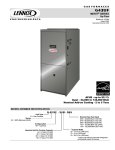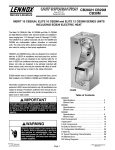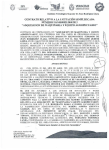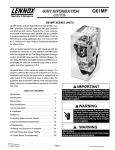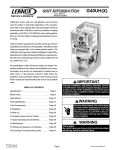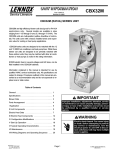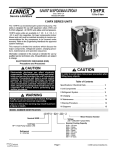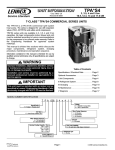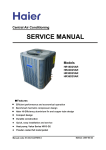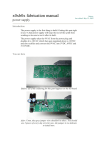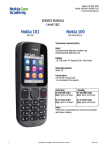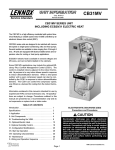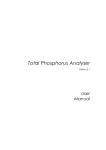Download IMPORTANT WARNING - INNOVATION GROUP
Transcript
CB26UH CBX26UH Corp. 0527−L10 Service Literature CB26UH &CBX26UH Series The CB26UH, and CBX26UH are high efficiency blower coils. Several models are available in sizes ranging from 1-1/2 through 5 tons (5.3 through 17.6 kW). The CBX26UH is designed for R−410A refrigerant and the CB26UH is designed for R−22 refrigerant. The units are up flow / horizontal that can be field converted to down flow applications. The units come with a factory installed check and expansion valve for cooling or heat pump applications. CB26UH and CBX26UH series units are designed to be matched with the 13SEER air conditioner and heat pump line, but can be matched with other air conditioners or heat pumps as noted in the rating information. See Engineering Handbook. Electric heat, in several kW sizes, can be field installed in the CB26UH and CBX26UH cabinets. Information contained in this manual is intended for use by experienced HVAC service technicians only. All specifications are subject to change. Procedures outlined in this manual are presented as a recommendation only and do not supersede or replace local or state codes. IMPORTANT Improper installation, adjustment, alteration, service or maintenance can cause property damage, personal injury or loss of life. Installation and service must be performed by a qualified installer or service agency. WARNING Electric shock hazard. Can cause injury or death. Before attempting to perform any service or maintenance, turn the electrical power to unit OFF at disconnect switch(es). Unit may have multiple power supplies. Page 1 Table of Contents Specifications / Electrical Data . . . . . . Blower Data . . . . . . . . . . . . . . . . . . . . . . I Application . . . . . . . . . . . . . . . . . . . . . . II Unit Components . . . . . . . . . . . . . . . . III Optional Electric Heat . . . . . . . . . . . IV Configuration Modification . . . . . . . V Start Up . . . . . . . . . . . . . . . . . . . . . . . . VI Typical Operating Characteristics . VII Maintenance . . . . . . . . . . . . . . . . . . . VIII Wiring Diagrams . . . . . . . . . . . . . . . NO TAG Page 3 Page 4 Page 5 Page 6 Page 10 Page 13 Page 14 Page 14 Page 15 © 2005 Lennox Industries Inc. Litho U.S.A. SPECIFICATIONS Model Number (R−22) Model Number (R−410A) CB26UH−018 CBX26UH−018 CB26UH−024 CBX26UH−024 CB26UH−030 CBX26UH−030 CB26UH−036 CBX26UH−036 1.5 2 2.5 3 Suction/Vapor line (o.d.) − in. (mm) sweat 3/4 (19) 3/4 (19) 7/8 (22.2) 7/8 (22.2) Liquid line (o.d.) − in. (mm) sweat 3/8 (9.5) 3/8 (9.5) 3/8 (9.5) 3/8 (9.5) Condensate − in. (mm) fpt (2) 3/4 (19) (2) 3/4 (19) (2) 3/4 (19) (2) 3/4 (19) Wheel nominal diameter x width − in. (mm) 10 x 6 (254 x 152) 10 x 6 (254 x 152) 11 x 8 (279 x 203) 11 x 8 (279 x 203) 1/4 (187) 1/4 (187) 1/4 (187) 1/3 (249) 16 x 20 x 1 (406 x 508 x 25) 16 x 20 x 1 (406 x 508 x 25) 18 x 20 x 1 (457 x 508 x 25) 18 x 20 x 1 (457 x 508 x 25) 208/240V 208/240V 208/240V 208/240V 15 15 15 15 1.5 1.5 1.6 1.8 129 (58) 131 (59) 148 (67) 148 (67) General D t Data Nominal tonnage Connections Blower Blower motor output − hp (W) 1 Filters Size of filter − in. (mm) ELECTRICAL DATA Voltage − 1 phase (60 hz) 2 Maximum overcurrent protection (unit only) 3 Minimum circuit ampacity (unit only) Shipping Data −1 package − lbs. (kg) SPECIFICATIONS Model Number (R−22) Model Number (R−410A) CB26UH−042 CBX26UH−042 CB26UH−048 CBX26UH−048 CB26UH−060 CBX26UH−060 3.5 4 5 Suction/Vapor line (o.d.) − in. (mm) sweat 7/8 (22.2) 7/8 (22.2) 7/8 (22.2) Liquid line (o.d.) − in. (mm) sweat 3/8 (9.5) 3/8 (9.5) 3/8 (9.5) Condensate − in. (mm) fpt (2) 3/4 (19) (2) 3/4 (19) (2) 3/4 (19) Wheel nominal diameter x width − in. (mm) 11 x 8 (279 x 203) 11 x 8 (279 x 203) 11−1/2 x 9 (292 x 229) 1/3 (249) 1/2 (373) 1/2 (373) 18 x 25 x 1 (457 x 635 x 25) 18 x 25 x 1 (457 x 635 x 25) 18 x 25 x 1 (457 x 635 x 25) 208/240V 208/240V 208/240V General D t Data Nominal tonnage Connections Blower Blower motor output − hp (W) 1 Filters Size of filter − in. (mm) ELECTRICAL DATA Voltage − 1 phase (60 hz) 2 Maximum overcurrent protection (unit only) 3 Minimum circuit ampacity (unit only) Shipping Data −1 package − lbs. (kg) 1 Filter is not furnished and must be field supplied. 2 HACR type circuit breaker or fuse. 3 Refer to National or Canadian Electrical Code 15 15 15 1.9 2.6 4.1 172 (78) 177 (80) 190 (86) manual to determine wire, fuse and disconnect size requirements. Use wires suitable for at least 167°F (75_C). OPTIONAL ACCESSORIES − MUST BE ORDERED EXTRA −018 −024 −030 −036 −042 −048 −060 Circuit Breaker Cover Kit 93M85 93M85 93M85 93M85 Down−Flow Conversion Kit 12W61 12W61 12W61 12W61 Model Horizontal Support Frame Kit 56J18 56J18 56J18 56J18 Side Return Unit Stand (Up−Flow Only) 45K32 45K32 45K32 45K32 Single Point Power Source Control Box (for Electric Heat) 21H39 21H39 21H39 21H39 Wall Hanging Bracket Kit (Up−Flow Only) 45K30 45K30 45K30 45K30 Page 2 BLOWER DATA CB(X)26UH−018 BLOWER PERFORMANCE Air Volume at External Static Specific Blower Taps Pressure High Low in. w.g. Pa cfm L/s cfm L/s .10 25 1020 460 755 340 .20 CB(X)26UH−024 BLOWER PERFORMANCE Air Volume at External Static Specific Blower Taps Pressure High Low in. w.g. Pa cfm L/s cfm L/s .10 25 1040 470 1000 455 50 960 435 715 325 .20 50 980 445 940 425 .30 75 885 400 675 305 .40 100 800 365 625 285 .30 75 905 410 870 395 .40 100 815 370 785 355 .50 125 690 315 570 .60 150 525 250 500 260 .50 125 705 320 680 310 235 .60 150 535 250 530 250 NOTE − All air data measured external to unit with dry coil and 1 inch non−pleated air filter in place. Electric heaters have no appreciable air resistance. NOTE − All air data measured external to unit with dry coil and 1 inch non−pleated air filter in place. Electric heaters have no appreciable air resistance. CB(X)26UH−030 BLOWER PERFORMANCE Air Volume at External Static Specific Blower Taps Pressure High Low in. w.g. Pa cfm L/s cfm L/s .10 25 1350 610 1145 520 CB(X)26UH−036 BLOWER PERFORMANCE Air Volume at External Static Specific Blower Taps Pressure High Low in. w.g. Pa cfm L/s cfm L/s .10 25 1560 705 1405 635 .20 50 1290 585 1090 495 .20 50 1480 670 1340 610 .30 75 1225 555 1030 465 .40 100 1150 520 960 435 .30 75 1390 630 1270 575 .40 100 1290 585 1185 540 .50 125 1065 485 875 .60 125 965 455 775 395 .50 125 1170 530 1090 495 365 .60 150 1015 480 975 460 NOTE − All air data measured external to unit with dry coil and 1 inch non−pleated air filter in place. Electric heaters have no appreciable air resistance. NOTE − All air data measured external to unit with dry coil and 1 inch non−pleated air filter in place. Electric heaters have no appreciable air resistance. CB(X)26UH−042 BLOWER PERFORMANCE Air Volume at External Static Specific Blower Taps Pressure High Low in. w.g. Pa cfm L/s cfm L/s .10 25 1940 880 1785 810 CB(X)26UH−048 BLOWER PERFORMANCE Air Volume at External Static Specific Blower Taps Pressure High Low in. w.g. Pa cfm L/s cfm L/s .10 25 1945 880 1870 850 .20 50 1845 835 1705 775 .20 50 1860 845 1790 810 .30 75 1745 790 1615 730 .40 100 1630 740 1515 685 .30 75 1765 800 1700 770 .40 100 1660 155 1600 725 .50 125 1495 680 1400 .60 150 1330 630 1265 635 .50 125 1540 700 1485 675 595 .60 150 1395 660 1350 635 NOTE − All air data measured external to unit with dry coil and 1 inch non−pleated air filter in place. Electric heaters have no appreciable air resistance. NOTE − All air data measured external to unit with dry coil and 1 inch non−pleated air filter in place. Electric heaters have no appreciable air resistance. CB(X)26UH−060 BLOWER PERFORMANCE Air Volume at External Static Specific Blower Taps Pressure High Low in. w.g. Pa cfm L/s cfm L/s .10 25 2160 980 2075 940 .20 50 2065 935 1985 900 .30 75 1960 890 1885 855 .40 100 1845 835 1775 805 .50 125 1710 775 1645 745 .60 150 1550 730 1495 705 NOTE − All air data measured external to unit with dry coil and 1 inch non−pleated air filter in place. Electric heaters have no appreciable air resistance. Page 3 CB26UH & CBX26UH PARTS ARRANGEMENT ELECTRIC HEAT SECTION (plate to be removed if installed) CONTROL BOX BLOWER COMPARTMENT COIL HORIZONTAL DRAIN PAN EXPANSION VALVE (R−22 or R−410A) UPFLOW DRAIN PAN FIGURE 1 ELECTROSTATIC DISCHARGE (ESD) Precautions and Procedures I−APPLICATION All major blower coil components must be matched according to Lennox recommendations for the unit to be covered under warranty. Refer to the Engineering Handbook for approved system matchups. A misapplied system will cause erratic operation and can result in early unit failure. The units come with factory installed check and expansion valve for all applications. The TXV valve has been installed internally for a cleaner installation and is accessible if required. CAUTION Electrostatic discharge can affect electronic components. Take precautions during unit installation and service to protect the unit’s electronic controls. Precautions will help to avoid control exposure to electrostatic discharge by putting the unit, the control and the technician at the same electrostatic potential. Neutralize electrostatic charge by touching hand and all tools on an unpainted unit surface before performing any service procedure. Page 4 II−UNIT COMPONENTS BLOWER ASSEMBLY A−Control Box The CB26UH and CBX26UH control box is located above the blower section shown in figure 1. Line voltage and electric heat connections are made in the control box. Optional electric heat fits through an opening located in the center of the control box. When electric heat is not used, cover plates cover the opening. The electric heat control arrangement is detailed in the electric heat section of this manual. 1−Transformer All CB26UH and CBX26UH series units use a single line voltage to 24VAC transformer mounted in the control box. The transformer supplies power to the control circuits in the indoor and outdoor unit. Transformers are rated at 40VA. 208/240VAC single phase transformers use two primary voltage taps as shown in figure 2. FIGURE 3 B−Blower Motor (B3) 208 / 240 VOLT TRANSFORMER PRIMARY CB26UH and CBX26UH units use single phase direct drive blower motors with a run capacitor. Figure 3 shows the parts arrangement. All motors have two speed taps. Typically, the high speed tap is energized during normal operation. SECONDARY ORANGE BLUE 240 VOLTS RED All units are factory wired for the high blower speed for heat pump and cooling applications with or without electric heat. No field wiring is required. The wiring diagrams show factory set blower speeds. 208 VOLTS YELLOW BLACK 1−Blower Motor Capacitor FIGURE 2 All CB26UH and CBX26UH series units use single phase direct drive motors with a run capacitor. The run capacitor is mounted on the blower housing. See figure 3. Capacitor ratings are shown on side of capacitor and indoor blower motor nameplate. 2−Blower Relay All CB26UH and CBX26UH units use a DPST relay to energize the blower motor. The relay coil is energized by blower demand from indoor thermostat. When the coil is energized, a set of N.O. contacts closes to energize the blower motor on cooling speed. When de−energized, a set of N.C. contacts allows the electric heat relay to energize the blower on heating speed (refer to unit wiring diagram). C−Coil CB26UH and CBX26UH units have dual slab coils arranged in an A" configuration. Each coil has two or three rows of copper tubes fitted with ripple−edged aluminum fins. An expansion valve, feeds multiple parallel circuits through the coils. The coil is designed to easily slide out of the unit cabinet. 3−Time Delay Relay The blower time delay is a 24 volt N.O. relay wired to the blower relay. See unit diagram. The delay is between 10 and 60 seconds and delays the blower on and off time in the cooling cycle. D−Plastic Drain Pans Drain pans are provided and installed on the CB26UH and CBX26UH, The drain pans are made from fiberglass filled plastic. Page 5 TABLE 1 III−OPTIONAL ECB26 ELECTRIC HEAT ECB29 CIRCUIT BREAKERS A−Matchups and Ratings UNIT CB1 AMPS CB2 AMPS CB3 AMPS ECB26-5CB-1 (P) 30 AMP −−− −−− ECB26-7CB-1 (P) 45 AMP −−− −−− ECB2610CB-1 (P) 60 AMP −−− −−− ECB26-15CB-1 (P) 60 AMP 30 AMP −−− ECB26-20CB-1 (P) 60 AMP 60 AMP −−− Tables 2 through 4 show all approved CB26UH and CBX26UH to ECB26 matchups and electrical ratings. B−Electric Heat Components ECB26 parts arrangement is shown in figure 4. All electric heat sections consist of components mounted to the electric heat vestibule panel and electric heating elements exposed directly to the airstream. 208/230V electric heat sections may be equipped with circuit breakers. The circuit breakers are designated by CB in the model number. 1−Electric Heat Sequencer Relays 1 and 2 Relays are N.O. sequencer relays with a resistive element for a coil and a bi-metal disk which actuates the contacts. The relays are located on the electric heat vestibule panel and are energized by a 24V heating demand (W1 and W2) via jack/plug 2. When energized, the internal resistance heats the bi-metal disk causing the contacts to close. When the relay is de-energized, the disk cools and the contacts open. The relays energize different stages of heat, as well as the blower. The blower is always first on and last off. 4−Heating Elements Heating elements are composed of helix wound bare nichrome wire exposed directly to the airstream. The elements are supported by insulators mounted to the wire frame. For single phase applications, one element is used per stage. Each stage is energized independently by the corresponding relay located on the electric heat vestibule panel. Once energized, heat transfer is instantaneous. High temperature protection is provided by primary high temperature limits. ECB26−7, -7CB, -10, -10CB 208/230 VESTIBULE PARTS ARRANGEMENT 2−Primary Limits 1, 2, 3 & 4 The primary limits are located on the electric heat vestibule panel and exposed directly to the airstream through an opening in the panel. They are SPST N.C. auto −reset limits. The limits are factory set and not adjustable. HEATING ELEMENTS ELECTRIC HEAT SEQUENCER 1&2 208/230 Volt Electric Heat Sections PRIMARY LIMITS 1, 2, 3 & 4 Each stage of the 208/230 electric heat is protected by a primary high temperature limit. Each stage uses the same style of limit. The primary limit is wired in series with a heat element. When either limit opens, the corresponding heat element is de-energized. All other heating elements remain energized. The primary high temperature limit opens at 150_F + 5_F (65.5_C + 2.8_C) on a temperature rise and automatically resets at 110_F + 9_F (43.3_C + 5.0_C) on a temperature fall. 3−Circuit Breaker Line voltage connections are made to circuit breakers in the electric heat sections with circuit breakers (designated by CB in the model numbers). Table 1 shows the amp rating for each circuit breaker used. Single phase electric heat uses two pole circuit breakers. CIRCUIT BREAKER FIGURE 4 Page 6 TABLE 2 CB(X)26UH−018 / CB(X)26UH−024 SINGLE PHASE ELECTRIC HEAT Description 5 kW ECB26−5 ((99M64)) Terminal Block ECB26−5CB ECB26 5CB (99M65) Ci Circuit it B Breaker k 7.5 kW ECB26−7 ((99M66)) Terminal Block ECB26−7CB ECB26 7CB (99M67) Ci Circuit it B Breaker k 10 kW ECB26−10 ((99M68)) Terminal Block ECB26−10CB ECB26 10CB (99M69) Ci Circuit it B Breaker k Volt 208 220 230 240 208 220 230 240 208 220 230 240 Input kW 3.8 4.2 4.6 5.0 5.6 6.3 6.9 7.5 7.5 8.4 9.2 10.0 1 Btuh 12,800 14,300 15,700 17,100 19,200 21500 23500 25,600 25,600 28,700 31,400 34,100 SINGLE PHASE ELECTRIC HEAT CB(X)26UH−030 Model Number 5 kW ECB26−5 ((99M64)) Terminal Block ECB26 5CB (99M65) Ci it B k ECB26−5CB Circuit Breaker 7.5 kW ECB26−7 ((99M66)) Terminal Block ECB26−7CB ECB26 7CB (99M67) Ci Circuit it B Breaker k 10 kW ECB26−10 ((99M68)) Terminal Block ECB26−10CB ECB26 10CB (99M69) Ci Circuit it B Breaker k 15 kW ECB26−15CB (99M70) ( ) Circuit Breaker 2 Minimum 3 Maximum Blower Circuit Overcurrent Motor Ampacity Protection Full Load Amps A Circuit 1 Circuit 2 Circuit 1 Circuit 2 1.5 19.5 −−− 30 −−− 1.4 22.2 −−− 30 −−− 1.4 22.2 −−− 30 −−− 1.4 22.2 −−− 30 −−− 1.5 28.6 −−− 45 −−− 1.4 32.7 −−− 45 −−− 1.4 32.7 −−− 45 −−− 1.4 32.7 −−− 45 −−− 1.5 37.6 −−− 60 −−− 1.4 43.1 −−− 60 −−− 1.4 43.1 −−− 60 −−− 1.4 43.1 −−− 60 −−− Volt 208 220 230 240 208 220 230 240 208 220 230 240 208 220 230 240 Input kW 3.8 4.2 4.6 5.0 5.6 6.3 6.9 7.5 7.5 8.4 9.2 10.0 11.3 12.6 13.5 15.0 1 Btuh 12,800 14,300 15,700 17,100 19,200 21500 23500 25,600 25,600 28,700 31,400 34,100 38,400 43,000 47,000 51,200 2 Minimum 3 Maximum Blower Circuit Overcurrent Motor Ampacity Protection Full Load Amps A Circuit 1 Circuit 2 Circuit 1 Circuit 2 1.6 19.6 −−− 30 −−− 1.5 22.3 −−− 30 −−− 1.5 22.3 −−− 30 −−− 1.5 22.3 −−− 30 −−− 1.6 28.7 −−− 45 −−− 1.5 32.8 −−− 45 −−− 1.5 32.8 −−− 45 −−− 1.5 32.8 −−− 45 −−− 1.6 37.7 −−− 60 −−− 1.5 43.2 −−− 60 −−− 1.5 43.2 −−− 60 −−− 1.5 43.2 −−− 60 −−− 1.6 37.7 18.1 60 30 1.5 43.2 20.8 60 30 1.5 43.2 20.8 60 30 1.5 43.2 20.8 60 30 NOTE − Circuit 1 Minimum Circuit Ampacity includes the Blower Motor Full Load Amps. 1 Electric heater capacity only − does not include additional blower motor heat capacity. 2 Refer to National or Canadian Electrical Code manual to determine wire, fuse and disconnect size requirements. Use wires suitable for at least 167°F (75_C). 3 HACR type breaker or fuse. Page 7 TABLE 3 SINGLE PHASE ELECTRIC HEAT CB(X)26UH−036 Description 5 kW ECB26−5 ((99M64)) Terminal Block ECB26−5CB C 26 C (99 (99M65) 6 )C Circuit Breaker 7.5 kW ECB26−7 ((99M66)) Terminal Block ECB26−7CB C C ((99M67)) C Circuit Breaker 10 kW ECB26−10 ((99M68)) Terminal Block ECB26−10CB C C ((99M69)) C Circuit Breaker 15 kW ECB26−15CB (99M70) ( ) Circuit Breaker Volt 208 220 230 240 208 220 230 240 208 220 230 240 208 220 230 240 Input kW 3.8 4.2 4.6 5.0 5.6 6.3 6.9 7.5 7.5 8.4 9.2 10.0 11.3 12.6 13.5 15.0 1 Btuh 12,800 14,300 15,700 17,100 19,200 21500 23500 25,600 25,600 28,700 31,400 34,100 38,400 43,000 47,000 51,200 SINGLE PHASE ELECTRIC HEAT CB(X)26UH−042 Model Number 5 kW ECB26−5 ((99M64)) Terminal Block ECB26−5CB C 26 C (99 (99M65) 6 )C Circuit Breaker 7.5 kW ECB26−7 ((99M66)) Terminal Block ECB26−7CB C 26 C (99 (99M67) 6 )C Circuit Breaker 10 kW ECB26−10 ((99M68)) Terminal Block ECB26−10CB C 26 10C (99 (99M69) 69) C Circuit Breaker 15 kW ECB26−15CB (99M70) ( ) Circuit Breaker 2 Minimum 3 Maximum Blower Circuit Overcurrent Motor Ampacity Protection Full Load Amps A Circuit 1 Circuit 2 Circuit 1 Circuit 2 1.8 19.8 −−− 30 −−− 1.7 22.5 −−− 30 −−− 1.7 22.5 −−− 30 −−− 1.7 22.5 −−− 30 −−− 1.8 28.9 −−− 45 −−− 1.7 33.0 −−− 45 −−− 1.7 33.0 −−− 45 −−− 1.7 33.0 −−− 45 −−− 1.8 37.9 −−− 60 −−− 1.7 43.4 −−− 60 −−− 1.7 43.4 −−− 60 −−− 1.7 43.4 −−− 60 −−− 1.8 37.9 18.1 60 30 1.7 43.4 20.8 60 30 1.7 43.4 20.8 60 30 1.7 43.4 20.8 60 30 Volt 208 220 230 240 208 220 230 240 208 220 230 240 208 220 230 240 Input kW 3.8 4.2 4.6 5.0 5.6 6.3 6.9 7.5 7.5 8.4 9.2 10.0 11.3 12.6 13.5 15.0 1 Btuh 12,800 14,300 15,700 17,100 19,200 21500 23500 25,600 25,600 28,700 31,400 34,100 38,400 43,000 47,000 51,200 2 Minimum 3 Maximum Blower Circuit Overcurrent Motor Ampacity Protection Full Load Amps A Circuit 1 Circuit 2 Circuit 1 Circuit 2 1.9 20.0 −−− 30 −−− 1.8 22.6 −−− 30 −−− 1.8 22.6 −−− 30 −−− 1.8 22.6 −−− 30 −−− 1.9 29.0 −−− 45 −−− 1.8 33.1 −−− 45 −−− 1.8 33.1 −−− 45 −−− 1.8 33.1 −−− 45 −−− 1.9 38.0 −−− 60 −−− 1.8 43.5 −−− 60 −−− 1.8 43.5 −−− 60 −−− 1.8 43.5 −−− 60 −−− 1.9 38.0 18.1 60 30 1.8 43.5 20.8 60 30 1.8 43.5 20.8 60 30 1.8 43.5 20.8 60 30 NOTE − Circuit 1 Minimum Circuit Ampacity includes the Blower Motor Full Load Amps. 1 Electric heater capacity only − does not include additional blower motor heat capacity. 2 Refer to National or Canadian Electrical Code manual to determine wire, fuse and disconnect size requirements. Use wires suitable for at least 167°F (75_C). 3 HACR type breaker or fuse. Page 8 TABLE 4 CB(X)26UH−048 SINGLE PHASE ELECTRIC HEAT Description 5 kW ECB26−5 ((99M64)) Terminal Block ECB26−5CB C 26 C (99 (99M65) 6 )C Circuit Breaker 7.5 kW ECB26−7 ((99M66)) Terminal Block ECB26−7CB C C ((99M67)) C Circuit Breaker 10 kW ECB26−10 ((99M68)) Terminal Block ECB26−10CB C C ((99M69)) C Circuit Breaker 15 kW ECB26−15CB (99M70) ( ) Circuit Breaker 20 kW ECB26−20CB (99M71) ( ) Circuit Breaker Volt 208 220 230 240 208 220 230 240 208 220 230 240 208 220 230 240 208 220 230 240 Input kW 3.8 4.2 4.6 5.0 5.6 6.3 6.9 7.5 7.5 8.4 9.2 10.0 11.3 12.6 13.5 15.0 15.0 16.8 18.4 20.0 1 Btuh 12,800 14,300 15,700 17,100 19,200 21500 23500 25,600 25,600 28,700 31,400 34,100 38,400 43,000 47,000 51,200 51,200 57,300 62,700 68,200 SINGLE PHASE ELECTRIC HEAT CB(X)26UH−060 Model Number 5 kW ECB26−5 ((99M64)) Terminal Block ECB26−5CB C C ((99M65)) C Circuit Breaker 7.5 kW ECB26−7 ((99M66)) Terminal Block C 26 C (99 6 )C ECB26−7CB (99M67) Circuit Breaker 10 kW ECB26−10 ((99M68)) Terminal Block C 26 10C (99 69) C ECB26−10CB (99M69) Circuit Breaker 15 kW ECB26−15CB (99M70) ( ) Circuit Breaker 20 kW ECB26−20CB (99M71) ( ) Circuit Breaker 2 Minimum 3 Maximum Blower Circuit Overcurrent Motor Ampacity Protection Full Load Amps A Circuit 1 Circuit 2 Circuit 1 Circuit 2 2.6 20.7 −−− 30 −−− 2.5 23.3 −−− 30 −−− 2.5 23.3 −−− 30 −−− 2.5 23.3 −−− 30 −−− 2.6 29.7 −−− 45 −−− 2.5 33.8 −−− 45 −−− 2.5 33.8 −−− 45 −−− 2.5 33.8 −−− 45 −−− 2.6 38.7 −−− 60 −−− 2.5 44.2 −−− 60 −−− 2.5 44.2 −−− 60 −−− 2.5 44.2 −−− 60 −−− 2.6 38.7 18.1 60 30 2.5 44.2 20.8 60 30 2.5 44.2 20.8 60 30 2.5 44.2 20.8 60 30 2.6 38.7 36.1 60 60 2.5 44.2 41.7 60 60 2.5 44.2 41.7 60 60 2.5 44.2 41.7 60 60 Volt Input 1 Btuh kW 208 220 230 240 208 220 230 240 208 220 230 240 208 220 230 240 208 220 230 240 3.8 4.2 4.6 5.0 5.6 6.3 6.9 7.5 7.5 8.4 9.2 10.0 11.3 12.6 13.5 15.0 15.0 16.8 18.4 20.0 12,800 14,300 15,700 17,100 19,200 21500 23500 25,600 25,600 28,700 31,400 34,100 38,400 43,000 47,000 51,200 51,200 57,300 62,700 68,200 2 Minimum 3 Maximum Blower Motor Circuit Overcurrent Full Load Ampacity Protection Amps (240V) Circuit 1 Circuit 2 Circuit 1 Circuit 2 4.1 22.2 −−− 30 −−− 3.9 24.7 −−− 30 −−− 3.9 24.7 −−− 30 −−− 3.9 24.7 −−− 30 −−− 4.1 31.2 −−− 45 −−− 3.9 35.2 −−− 45 −−− 3.9 35.2 −−− 45 −−− 3.9 35.2 −−− 45 −−− 4.1 40.2 −−− 60 −−− 3.9 45.6 −−− 60 −−− 3.9 45.6 −−− 60 −−− 3.9 45.6 −−− 60 −−− 4.1 40.2 18.1 60 30 3.9 45.6 20.8 60 30 3.9 45.6 20.8 60 30 3.9 45.6 20.8 60 30 4.1 40.2 36.1 60 60 3.9 45.6 41.7 60 60 3.9 45.6 41.7 60 60 3.9 45.6 41.7 60 60 NOTE − Circuit 1 Minimum Circuit Ampacity includes the Blower Motor Full Load Amps. 1 Electric heater capacity only − does not include additional blower motor heat capacity. 2 Refer to National or Canadian Electrical Code manual to determine wire, fuse and disconnect size requirements. Use wires suitable for at least 167°F (75_C). 3 HACR type breaker or fuse. Page 9 IV−CONFIGURATION MODIFICATIONS CB26UH and CBX26UHunits are factory−assembled and configured for installation in upflow or horizontal left−hand air discharge applications. A kit is available to convert units for downflow applications. See OPTIONAL ACCESSORIES at the front of this manual. 4. Install units that have no return air plenum on a stand that is at least 14" from the floor. This will allow proper air return. Upflow Configuration If the unit needs to be modified from its original configuration, use the following procedures. All procedures assume the unit has not been modified from the factory. HORIZONTAL DRAIN PAN (Remove for best upflow performance) General Information WARNING Improper installation, adjustment, alteration, service or maintenance can cause property damage, personal injury or loss of life. Installation and service must be performed by a qualified installer or service agency. Each unit consists of a blower assembly, refrigerant coil, and controls, in an insulated galvanized steel factory finished enclosure. Knockouts are provided for electrical wiring entrance. For ease in installation, it is best to make any necessary coil configuration changes before setting air handler in place. If a filter is to be installed at the air handler, a filter rack must be formed using factory−supplied flanges. Lay the unit on its back and pry out the filter rack tabs as shown in figure 5. Filter Rack Tabs HORIZONTAL DRAIN CONNECTIONS (Both sides; Not used) UPFLOW DRAIN PAN UPFLOW DRAIN CONNECTIONS (Both sides; use on side or other) FIGURE 6 Horizontal Applications NOTE − When the unit is installed in horizontal applications, a secondary drain pan is recommended. Refer to local codes. This unit may be installed in left−hand or right−hand air discharge horizontal applications. Adequate support must be provided to ensure cabinet integrity. Ensure that there is adequate room to remove service and access panels if installing in the horizontal position. 1. Determine whether left-hand or right-hand air discharge is required. If right-hand is required, perform Right−Hand Discharge Modification. See next page. 2. Determine knockouts required for drain line connections. 3. With access door removed, knock out drain line opening for installing drain lines. 4. Set unit so that it is sloped (up to 1/4 inch) toward the drain pan end of the unit. 5. The horizontal configuration is shown in figure 7. Left−Hand Air Discharge Configuration AIR FLOW FIGURE 5 Drains Upflow Application 1. The air handler must be supported on the bottom only and set on solid floor or field-supplied support frame. Securely attach the air handler to the floor or support frame. 2. If installing a unit in an upflow application, remove the horizontal drain pan; it is not required in upflow air discharge installations. 3. Place the unit in desired location. Set unit so that it is level. Connect return and supply air plenums as required using sheet metal screws. KNOCKOUT LEFT-HAND DRAINS FIGURE 7 6. If the unit is suspended, the entire length of the cabinet must be supported. If you use a chain or strap, use a piece of angle iron or sheet metal attached to the unit (either above or below) to support the length of the cabinet. Use securing screws no longer than 1/2 inch to avoid damaging the coil or filter. See figure 8. Use sheet metal screws to connect the return and supply air plenums as required. Page 10 Suspending Horizontal Unit ANGLE IRON OR SHEET METAL Field Modification for Right−Hand Discharge REMOVE DRAIN PAN FROM HERE THEN... Electrical Inlet Clearance 4 in. (102 mm) 1/2 in. Screws max. REINSTALL PAN HERE REMOVE 2 SCREWS AND BP BRACKET FROM HERE THEN... AIR FLOW ROTATE BP BRACKET AND REINSTALL FRONT VIEW REMOVE COIL SUPPORT BRACKET FROM HERE THEN... END VIEW FIGURE 8 REINSTALL BRACKET HERE IMPORTANT When removing the coil, there is possible danger of equipment damage and personal injury. Be careful when removing the coil assembly from a unit installed in right− or left−hand applications. The coil may tip into the drain pan once it is clear of the cabinet. Support the coil when removing it. BRACKET SHOWN AS SHIPPED Right−Hand Air Discharge Modification BRACKET SHOWN FOR RIGHT HAND DISCHARGE Right−Hand Air Discharge Configuration DETAIL A AIR FLOW DETAIL B FIGURE 10 Drains KNOCKOUT RIGHT-HAND DRAINS FIGURE 9 For horizontal right−hand air discharge, the following field modifications are required. 1. Remove and set aside blower and coil access covers. 2. Remove the coil support bracket (see detail A, figure 10). 3. Remove coil assembly, bottom drain pan and horizontal drain pan as one assembly from the air handler. 4. Remove the drain plugs from back of horizontal drain pan and reinstall in the front holes. 5. Remove two screws and blowoff prevention bracket (BP BRACKET" in figure 10). Rotate the bracket 180º and reinstall using the same screws. 6. Move horizontal drain pan to the opposite side of the coil. Plugged drain holes will now be toward the back of the unit (see figure 11). 7. Re−install modified coil/drain pan assembly in air handler in the same orientation as before. 8. Install the coil support bracket on the opposite side of the air handler (detail B, figure 10).. Page 11 Right-Hand Discharge Drain Plug Location PLUGGED END ORIGINAL PLUG LOCATION COIL ASSEMBLY OPEN END FOR CONDENSATION DRAIN NEW PLUG LOCATION FIGURE 11 Install Condensate Drain The air handler is provided with ¾" NPT condensate drain connections. 4. Install a 3" trap in both the primary and secondary drain lines as close to the unit as practical (see figure 13). Make sure the top of the trap is below the connection to the drain pan to allow complete drainage of the pan. IMPORTANT Typical Condensate Drain Connection (Secondary Drain Not Shown) A field−fabricated secondary drain pan, with a drain pipe to the outside of the building, is required in all installations over a finished living space or in any area that may be damaged by overflow from the main drain pan. In some localities, local codes may require an secondary drain pan for any horizontal installation. AIR HANDLER DRAIN CONNECTION ANTI−SIPHON AIR VENT DRAIN LINE 1" Min. DRAIN PAN 12" Max. Make sure the unit is sloped (up to 1/4 inch) so that the drain pan will empty completely without water standing in the pan. See figure 12. THIS CORNER SHOULD BE 5/8I (+/- 1/8I) HIGHER THAN DRAIN CORNER THIS CORNER SHOULD BE 5/8I (+/- 1/8I) HIGHER THAN DRAIN CORNER DRAIN CORNER FIGURE 12 1. Remove the appropriate drain knockouts. If necessary, remove the indoor coil assembly from the cabinet. 2. Connect primary drain line connection to the primary drain pan connection. The primary drain connection is flush with the bottom of the inside of the pan. Secondary connection is raised above the bottom of the inside of the pan. NOTE − When making drain fitting connections to the drain pan, hand tighten the fitting and use a sealant. Overtightening the fittings can split connections on the drain pan. 3. Secondary drain connections, if used, should be connected to a separate drainage system. Run the secondary drain line to a place where the occupant would be sure to notice any drainage from the drain. 3" Min. DRAIN TRAP FIGURE 13 NOTE − Horizontal runs over 15 ft. long must also have an antisiphon air vent (standpipe) installed ahead of the horizontal run (See figure 13). An extremely long horizontal run may require an oversized drain line to eliminate air trapping. NOTE − Do not operate air handler without a drain trap. The condensate drain is on the negative pressure side of the blower; therefore, air being pulled through the condensate line will prevent positive drainage without a proper trap. 5. Route the drain line to the outside or to an appropriate drain. Drain lines must be installed so they do not block service access to the front of the air handler. A 24" clearance is required for filter, coil, or blower removal and service access. NOTE − Check local codes before connecting the drain line to an existing drainage system. 6. Insulate the drain lines where sweating could cause water damage. Test Condensate Drain Test the drain pan and drain line after installation: 1. Pour several quarts of water into drain pan, enough to fill drain trap and line. 2. Check to make sure the drain pan is draining completely, no leaks are found in drain line fittings, and water is draining from the end of the primary drain line. 3. Correct any leaks found. Page 12 setting far enough below room temperature to bring on the compressor. Compressor will start and cycle on demand from the thermostat. After a 30 second time delay (approximate) the indoor blower will energize. V−START-UP − OPERATION A−Preliminary and Seasonal Checks 1− Make sure the unit is installed in accordance with the installation instructions. 2− Inspect electrical wiring, both field and factory installed for loose connections. Tighten as required. 3− Check voltage at disconnect switch. Voltage must be within range listed on the nameplate. If not, consult the power company and have voltage condition corrected before starting unit. 2− The refrigerant circuit is charged with R−22 or R−410 refrigerant. See condensing unit rating plate for correct charge amount. 3− Refer to the correct condensing unit service manual for more information. C−Heating Start-Up 4− Check to ensure that refrigerant lines are in good condition and pipe insulation is intact. 1− Set the fan switch to AUTO or ON and move the system selection switch to HEAT. Adjust the thermostat setting above room temperature. 5− Inspect condition of condensate drain pan and piping assembly. Disassemble and clean seasonally. 2− The indoor blower and the electric heat will stage on based on sequencer timing. D−Safety or Emergency Shutdown B−Cooling Start-Up Turn off unit power at circuit breaker. NOTE−The following is a generalized procedure and does not apply to all thermostat control systems. Electronic thermostat control systems may operate differently. E−Extended Period Shutdown 1− Set fan switch to AUTO or ON and move the system selection switch to COOL. Adjust the thermostat to a Turn off thermostat or set to UNOCCUPIED" mode. Turn off power to unit. All access panels and covers must be in place and secured. The condensate assembly should be clean and dry for extended period shutdown. Page 13 VI−TYPICAL OPERATING CHARACTERISTICS A−Blower Operation and Adjustment NOTE− The following is a generalized procedure and does not apply to all thermostat controls. 1− Blower operation is dependent on thermostat control system. 2− Generally, blower operation is set at thermostat subbase fan switch. With fan switch in ON position, blower operates continuously. With fan switch in AUTO position, blower cycles with demand. 3− In all cases, blower and entire unit will be off when the system switch is in OFF position. B−External Static Pressure 1− Measure tap locations as shown in figure 14. STATIC PRESSURE TEST MANOMETER SUPPLY 1. Disconnect all power supplies. 2. Remove the air handler access panel. 3. Locate pin number 2 on the blower relay. Two black wires are connected to this terminal pin. One connects to pin number 5 on the blower relay, one connects to an inline splice connecting to a red or blue wire. 4. Remove the wire going to the 4−pin blower motor connector from the splice. 5. Connect the blower lead [Red (LO), Black (HI)] onto the splice from the 4−pin blower motor connector. NOTE − Unused blower speed taps are factory−covered with plastic caps. Remove this cap from the desired blower speed tap and replace it over the factory− set blower tap. 6. Replace all panels. 7. Reconnect power. VII−MAINTENANCE WARNING RETURN Disconnect power before performing any maintenance. UNIT SHOWN IN HORIZONTAL DISCHARGE LEFT POSITION FIGURE 14 2− Punch a 1/4" (6mm) diameter hole in supply and return air plenums. Insert manometer hose flush with inside edge of hole or insulation. Seal around the hose with permagum. Connect the zero end of the manometer to the discharge (supply) side of the system. On ducted systems, connect the other end of manometer to the return duct as above. For systems with non−ducted returns, leave the other end of the manometer open to the atmosphere. 3− With only the blower motor running and the evaporator coil dry, observe the manometer reading. Adjust blower motor speed to deliver the air desired according to the job requirements. At the beginning of each heating/cooling season, the system should be checked as follows: A−Filters NOTE− Filter access panel must be in place during unit operation, or excessive warm air may enter the unit resulting in water blow−off problems. TABLE 5 Unit Air Filter Size Chart Model 18 / 24 30 / 36 42 / 48 / 60 Filter Size 16" x 20" 18" x 20" 18" x 25" 5− Seal around the hole when the check is complete. To remove filter, remove 1/4" head screws holding the filter panel in place. Slide filter out of the guides on either side of cabinet, insert new filter and replace panel. Filters should be inspected monthly and must be replaced when dirty to ensure proper blower coil operation. See table 5 for replacement filter sizes. C−Blower Speed Taps B−Supply Air Blower 4− For best air performance external static pressure drop must not exceed 0.5" W.C. (1.2 kPa). Refer to blower data tables for cfm and external static. Change Blower Speed WARNING Electric shock hazard! − Disconnect all power supplies before servicing. Replace all parts and panels before operating. Failure to do so can result in death or electrical shock. 1- Check and clean blower wheel. 2- Motors are prelubricated for extended life; no further lubrication is required. C−Electrical 1- Check all wiring for loose connections. 2- Check circuit breaker located in unit control box. 3- Check for correct voltage at unit (unit operating). 4- Check amp-draw on blower motor. 5- Check to see that heat (if applicable) is operating. Page 14 VIII−WIRING DIAGRAMS AND SEQUENCE OF OPERATIONS 6 SEQUENCER 2 12 BK 12 BK L1B 3 1 12 BK GND 220 208/240 VOLTAGE BY OTHERS 12 Y 12 BK 12 BK L2A 7 12 Y SEQUENCER 1 CIRCUIT BREAKER 1 (OPT) L1A LIMIT SWITCH 4 HE3 18 BU L2B HE4 5 ELECTRIC HEAT − 2ND STAGE 18 BK 12 BK LIMIT SWITCH 3 4 CIRCUIT BREAKER 2 (OPT) 3 ELECTRIC HEAT − 1ST STAGE LIMIT SWITCH 1 5 4 12 BK 3 1 12 BK 4 HE1 HE2 LIMIT SWITCH 2 12 Y 2 3 4 1 2 3 4 6−PIN PLUG 5 6 5 6 18 BK W2 1 18 W W1 TRANSFORMER 24 18 BU C 18 G G 18 R R 3 24V H 18 BU H 8 18 G 18 BU C 18 BU 14 BK 208V 240V 18 R 14 R 14 Y L2 14 BK L1 6 COM 3 6 3 4 5 6 6−PIN PLUG HEATER ELEMENTS USED: 5KW − HE1 7.5 & 10KW − HE1 & HE2 15KW − HE1, HE2, & HE3 20KW − HE1, HE2, HE3, & HE4 BK W BU G 2 R TIME DELAY H =10 TO 60 SECONDS TO HEAT UP C =10 TO 60 SECONDS TO COOL DOWN 1 5 5 2 4 BLOWER RELAY 2 POWER (FACTORY WIRED) POWER (FIELD WIRED) CONTROL (FACTORY WIRED) CONTROL (FIELD WIRED) CONTROL CIRCUIT WIRING TO BE 24 VOLT, N.E.C. CLASS 2 TO THERMOSTAT 1 1 18 BK 18 W 14 R TO BLOWER GROUND LUG 18 BU GND 14 G 14 Y 14 BK 12 Y 14 R (LO) 9 14 BK (HI) 14 Y (COM) 4 3 2 1 R BK Y+ BR/W BLOWER MOTOR BR MOTOR CAPACITOR A−ECB26UH & ECBX26UH − SEQUENCE OF OPERATION FIRST STAGE HEAT 1− Line voltage is routed to transformer and blower relay. 2− 24VAC is supplied to indoor thermostat and electric heat, if used. 3− When there is a call for heat W1 of the thermostat energizes sequencer relay 1. 4− Assuming limit switch 1 and 2 are closed, sequencer relay 1 energizes HE1 and HE2. 5− Indoor blower is energized on heating speed, after sequencer timing is complete. SECOND STAGE HEAT 6− W2 in the thermostat energizes sequencer relay 2. 7− Assuming limit switch 3 and 4 are closed sequencer relay energizes HE3 and HE4. COOLING 8− When there is a call for cooling, G of the thermostat energizes blower time delay relay. 9− After a 30 second delay (approximate) blower relay energizes blower motor on cooling speed. Blower will also delay 30 seconds after cool demand is satisfied. Page 15

















